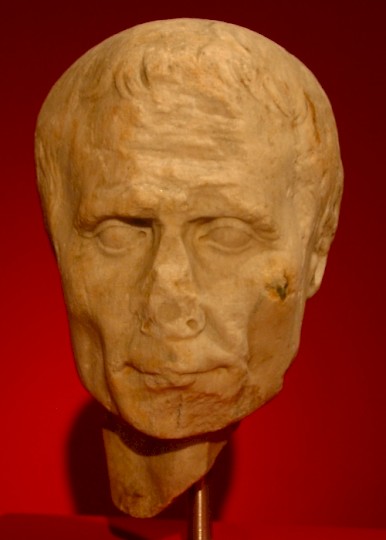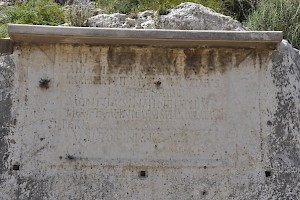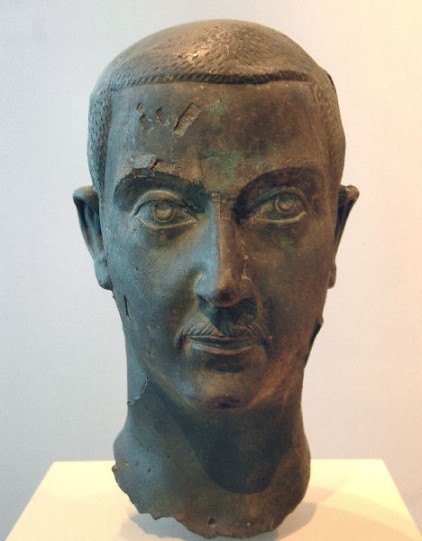Legio III Gallica
Legio III Gallica: one of the Roman legions. Its name means "the legion from Gaul".

This legion was founded in 49 or 48 BCE by Julius Caesar, who needed it in his war against his fellow-triumvir and rival Pompey the Great. The surname Gallica shows that its recruits came from northern Italy or the Provence, i.e. the two provinces of Caesar, Gallia Cisalpina and Gallia Transalpina. The unit saw its first action at Dyrrhachium (spring 48). It was present at Munda (17 March 45). After Caesar had been murdered, the legion became part of the army of Mark Antony.
In 42, it fought for the members of the Second Triumvirate in the battle of Philippi and the first generation of veterans was later settled at Perugia. It is likely that they played a leading part in the war that broke out between the adherents of Mark Antony's brother Lucius and Octavian, a relative of Caesar who was becoming very popular. Perugia was besieged by the Octavians and the Antonians were forced to surrender (41).
In the meantime, the legion had been sent to the east, which was controlled by Mark Antony. It was possibly part of the army that the Roman authorities gave to their vassal king Herod of Judaea to reconquer his kingdom in the early 30s. The legion certainly participated in Antony's ill-fated war against the Parthian empire (36). It seems that the third Gallic legion fought heroically during the retreat from enemy country and more or less saved the rest of the army.
After the naval battle of Actium (31), in which Octavian defeated Mark Antony, the Third was integrated into the army of Octavian (the later emperor Augustus). He sent the legion back to Syria (together with VI Ferrata, X Fretensis and XII Fulminata). In 20, Augustus' stepson (and future successor) employed these legions, and perhaps V Macedonica as well, to impress the Parthians; they returned the eagle standards they had obtained after the Roman general Crassus' defeat at Carrhae in 53 BCE.
During the next decades, the legion is hardly mentioned. The governor of Syria, Publius Quinctilius Varus, used three of the Syrian legions to suppress the rebellions of the Jewish messianic claimants Judas, Simon, and Athronges after the death of king Herod in 4 BCE. It is likely that III Gallica was among them, but we are not certain. During the reign of Tiberius (14-37), a soldier was buried on Cyprus, which suggests some sort of (not necessarily military) activity on this island. We also know that in 45, the emperor Claudius refounded Ptolemais (modern Acre) as a colonia and settled veterans of the four Syrian legions in the city.
During the reign of the emperor Nero, the Third was commanded by Gnaeus Domitius Corbulo in his war against the Parthian empire. Ignoring a treaty, the Parthian king Vologases I had installed his brother Tiridates as king of Armenia. As the Romans traditionally had the right to choose the Armenian king, they now launched a war. Using III Gallica, VI Ferrata, and X Fretensis, Corbulo captured the Armenian capitals Artaxata (south of modern Yerevan; 58) and Tigranocerta (59), and gave the Armenians a new, pro-Roman king, Tigranes (a great-grandson of the Jewish king Herod the Great). However, the Parthians continued to support Tiridates and were able to place him on the throne again.

A retaliatory campaign was organized by Lucius Caesennius Paetus, the governor of Cappadocia, in 62. He used XII Fulminata and IIII Scythica. However, the Parthians forced them into surrender at Rhandeia (winter 62/63). Later, Corbulo and his legions were able to turn the tables, and the general ordered Tiridates to receive his crown for the second time from the Roman emperor Nero in Italy.
As long as Corbulo remained in command, the legion stayed in Armenia, where its presence at a castle named Ziata is attested in 64. Two years later, a subunit took part in Gaius Cestius Gallus' campaign against the Jews, who had revolted (more). Although this expedition was a failure and the situation in Jerusalem deteriorated, Nero moved III Gallica away from the east and sent it to Oescus, in Lower Moesia on the Danube, where it replaced V Macedonica. It is likely that the pressure on the Danube frontier was more acutely felt than the Jewish war. However this may be, the Third, supported by a subunit of VIII Augusta, defeated the Sarmatian tribe of the Roxolani in the winter of 68-69.

The third legion was still in Moesia when Nero committed suicide and civil war broke out between the Roman emperors Galba, Otho, and Vitellius (69). Like the rest of the Danube army, it first sided with Otho, but arrived too late in Italy to prevent his defeat by Vitellius. It returned to Moesia, but immediately sided with Vespasian, a new rebel. He was commander in chief of the army fighting against the Jews. III Gallica still sympathized with the army of the East and therefore supported its pretender. This is remarkable, however, because its commander was Gaius Dillius Aponianus, a cousin of Gaius Dillius Vocula, who commanded XXII Primigenia, one of Vitellius' most loyal legions.
The Vitellian and Vespasian armies met in the battle of Cremona, where soldiers of the Third decided the fight by a misunderstanding. As the sun was rising, they greeted it according to their custom - the Syrians venerated the sun god Elagabal - but the followers of Vitellius suspected that reinforcements had arrived, and took to flight. After this victory, they soldiers of the Third were the first to enter the town of Cremona, which was sacked.

After the capture of Rome and the death of Vitellius, Vespasian's general Antonius Primus sent III Gallica to Capua, which had been conspicuously loyal to Vitellius. It now had to feed the legion during the winter. However, the soldiers were not to rest for a long time: they were sent back to Syria, which needed to be regarrisoned because many troops were now fighting in Judaea. This transfer to the original province, where most of its soldiers had their families, was widely seen as a reward for its service to Vespasian.
Its base was probably at Raphanaea, halfway Antioch and Damascus. We are not completely certain about this, but we know for sure that Raphanea was the legion's home in the second century, and we also know that the base had recently been evacuated by XII Fulminata, which had been transferred to Commagene. The Romans conquered this country along the Upper Euphrates in 71; III Gallica may or may not have taken part in the expedition.
One of the military tribunes in these years was Pliny the Younger, who became famous as author of beautiful letters. Oddly enough, the legion now completely disappears from our sources. Subunits may have taken part in the wars of Domitian and Trajan against Dacia, and it would be extremely improbable if III Gallica had not taken part in Trajan's expedition against the Parthian empire, but our sources remain silent.
In the 130s, the Third Gallic Legion fought against the Jews, who revolted in 132 under Simon ben Kosiba (more). Several inscriptions mention soldiers with rewards for heroic behavior in this Jewish war, which lasted until 136 and demanded the emperor Hadrian's personal attention.
The legion also had its share of the campaigns of Lucius Verus against the Parthian empire (161-166). It even crossed the Tigris and could rightfully claim to have invaded Media. Later, it captured the Parthian capitals Seleucia and Ctesiphon. The successful legionary commander was Avidius Cassius, who was to usurp the emperor's purple briefly in 175. During Verus' campaign, the annexation of land on the east bank of the Euphrates was contemplated, but turned out to be impossible because of the outbreak of an epidemic.
Soldiers of III Gallica were employed all over Syria. Inscriptions attest to their presence in the north at Cyrrhus, the Euphrates in the west, the former kingdom of Julius Marcus Agrippa in the south and coast towns like Sidon and Aradus in the west.

On 31 December 192, the emperor Commodus was assassinated and on New Year's day, he was succeeded by the old general Publius Helvius Pertinax, a former governor of Syria. Although he was immediately recognized, he lost control of the situation and was murdered. The imperial guard chose Didius Julianus, another capable general, as its emperor, and civil war broke out. The Syrian legions supported Pescennius Niger; those of the west Clodius Albinus; and those of the Danube Lucius Septimius Severus. The latter was the first to reach Rome, where he had Didius Julianus executed. After signing an armistice with Clodius Albinus, he marched to the east, where he attacked and defeated Pescennius Niger (194).
Immediately, Septimius Severus launched an attack upon the Parthian empire. It was important because he could shown the Roman world that he was not merely fighting civil wars. Besides, it was a way of reintegrating Pescennius' legions in the Roman army again. In 195, Nisibis and Edessa in Mesopotamia were taken. War was broken off, however, because Clodius Albinus broke his treaty with Severus; but when he had defeated his opponent, Severus returned to the east and in 197/198 attacked southern Mesopotamia, where his soldiers captured Babylon, Seleucia and Ctesiphon. This is shown on Severus' triumphal arch in Rome. Soldiers of III Augusta, the legion that had already captured the Parthians capitals before, must have been present during the siege.

Septimius Severus reorganized the east. Mesopotamia was annexed to the empire and occupied by two new legions (I Parthica and III Parthica). At the same time, Syria was divided, because it was too dangerous for a governor to command several legions, as Pescennius Niger had shown. Raphanaea now belonged to the new province of Syria Phoenicia; veterans were settled in the provincial capital, Tyre. Cooperation between III Gallica and the legions of the Euphrates now was becoming increasingly rare; the legion no longer looked to the east, but to the west, to the Mediterranean. An inscription at the Nahr al-Kalb tells that the soldiers of the Third built a road.note
It was still there in 217, when the emperor Caracalla was murdered at Harran and succeeded by Macrinus, the praetorian prefect who was also responsible for Rome's strategic reserve, II Parthica. His accession, however, was not uncontested. A relative of Caracalla, a boy named Bassianus who was priest of the sun god Elagabal, fled to the fortress of III Gallica with his mother. The soldiers, led by their commander Publius Valerius Comazon Eutychianus, supported his claim to the throne, which rightfully belonged to his family. Macrinus sent an army to suppress the rebels, but before the battle II Parthica switched sides. This was the end of the reign of Macrinus and the beginning of the rule of Bassianus, who was from now on known as the boy-emperor Heliogabalus. Eutychianus was rewarded with the office of praetorian prefect.

He was unable to retain the sympathy of the soldiers. In 219, the new commander of III Gallica, Verus, revolted, and although he was swiftly removed, Heliogabalus disbanded the legion. The soldiers were transferred to III Augusta in northern Africa. However, the unit was reconstituted by Heliogabalus' successor Severus Alexander (222-235). From that moment on, it was no longer in Raphaea, but guarded the road from Palmyra to Damascus. The new base was close to the last-mentioned city.
The Third must have taken part in war waged by Severus Alexander against the new, Sasanian Persian empire. The Sasanians had invaded the Roman empire in 230 and had installed an emperor in Emessa, but Severus Alexander was able to restore order and invade Mesopotamia. In 244, the Romans again invaded the country between Euphrates and Tigris, but their emperor Gordian III died and was succeeded by Philippus Arabs, who owed his throne to the Sasanian king Shapur I.
The Third's commander in the mid-third century was Publius Licinius Valerianus. A rather unreliable source, the Historia Augusta, suggests that in 251, he and the legion took part in the Gothic war of Deciusnote and that Valerian, as emperor, transferred command of this unit to the future emperor Aurelian. It is not impossible.

The legion must have taken part in the war that its former commander Valerian, who had become emperor in 253, launched against the Sasanians. This had become necessary because the Persians had captured Satala, the fortress of XV Apollinaris, on the Upper Euphrates. In 260, he was not only defeated but also captured. Captive Roman soldiers were ordered to build a bridge at modern Shushtar. The accession of Philip the Arab and the defeats of Gordian and Valerian are commemorated on several Sasanian monuments.
However, under Odaenathus of Palmyra (261-267), the Romans restored their fortunes. He remained loyal to the empire, but after his death, his wife Zenobia declared Palmyra to be independent. During the reign of Aurelian (270-275), order was restored in the east, and soldiers of the Third took part in the sack of Palmyra.
However, coins suggest that at least a part of III Gallica was in Gaul during the reign of the Gallic emperor Postumus (260-269). It is not impossible that the legion was first in Syria, then in Gaul, and then in Syria again, but it is not very likely.
During the reign of Diocletian (284-305), the Romans further improved their positions and in 298, a peace treaty was concluded in which the Persians had to give up territories in northern Mesopotamia. The third legion must have played a role during the campaigns, but we have almost no information about them.
After the reign of Aurelian, the legion is usually mentioned together with a newly created unit that also served in southern Syria, I Illyricorum. A subunit made up from soldiers of these two legions was active in Egypt in 315-316 and is known to have stayed at Syene on the empire's southern border in 323. In both cases, the commander was one Victorinus. This is the last time we hear of the third Gallic legion, which is not mentioned in our sources of the late fourth or fifth centuries.
Like almost all Caesarian legions, the emblem of this legion was a bull.
Literature
- E. Dabrowa, "Legio III Gallica", in: Yann Le Bohec, Les légions de Rome sous le Haut-Empire (2000 Lyon) 309-315
- I. Piso, "Les légions dans la province de Dacie", in: Yann Le Bohec, Les légions de Rome sous le Haut-Empire (2000 Lyon) 205-225